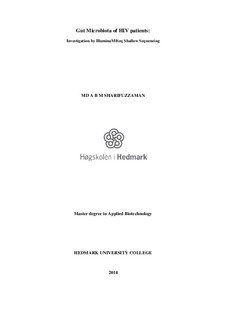| dc.contributor.author | Sharifuzzaman, Md A B M | |
| dc.date.accessioned | 2015-04-14T08:28:28Z | |
| dc.date.available | 2015-04-14T08:28:28Z | |
| dc.date.issued | 2014 | |
| dc.identifier.uri | http://hdl.handle.net/11250/281606 | |
| dc.description | Mastergradsoppgave i næringsrettet bioteknologi, Avdeling for lærerutdanning og naturvitenskap, Høgskolen i Hedmark, 2014. Master of applied and commercial biotechnology. | nb_NO |
| dc.description.abstract | The colonization of a healthy gastrointestinal (GI) tract is a primary target for HIV infection. HIV infection causes inflammation, which results in disruption of the mucosal surface of the gut and the breakdown of the gut wall integrity which causes the free flow of pathogenic microbes to the lymph nodes. HIV infection causes alteration of gut microbiota in affected subjects, compared with healthy subjects. However the pattern of gut microbiota depends on many variables. Studies supported that probiotic supplement could bring back the normal gut microbiota to some extent as well as possibly suppressing pro inflammatory responses. This study is aimed at investigating the relationship between the gut microbiota and HIV infection progression in the Swedish patients. There were fifteensubjects under this study and divided into five groups (three subjects in each) such as Baseline, Follow up, Elite control, Immune-deficient and Control. One subject of Elite control was rejected as it was failed QC of MG-RAST.The analysis of gut microbiota is carried out through library preparation and sequencing using theNextera XT DNA kit and MiSeqsystem, respectivelyat the in Norwegian Univeristyof Life Science. The taxonomical and functional abundance was analyzed by the help of the MG-RAST pipeline. The abundance between groups were significantly different in different taxonomical levels from phylum to genus. Firmicuteswas the only bacterial phyla whose abundance was found significantly different between the subject groups. Akkermansiamuniciphilawas the only bacterial species which represent the bacterial phylum Verrucomicrobia, and weremost abundant in the immune-deficient group. Clostridia, bacteria that play a critical role in the body's immune defense mechanism, were less abundant in the control group than the infected groups. Bacterial families showed much more variety of abundance among the groups. Bacterial genes functioning for membrane transport, defense, virulence and disease were less abundant in immune-deficient group. | nb_NO |
| dc.language.iso | eng | nb_NO |
| dc.subject | HIV | nb_NO |
| dc.subject | Applied and commercial biotechnology | nb_NO |
| dc.subject | Næringsrettet bioteknologi | nb_NO |
| dc.subject | gut microbiota | nb_NO |
| dc.subject | probiotics | nb_NO |
| dc.subject | MG-RAST | nb_NO |
| dc.subject | taxonomical abundance | nb_NO |
| dc.subject | functional abundance | nb_NO |
| dc.title | Gut Microbiota of HIV patients: Investigation by IlluminaMiSeq Shallow Sequencing | nb_NO |
| dc.type | Master thesis | nb_NO |
| dc.subject.nsi | VDP::Technology: 500::Biotechnology: 590 | nb_NO |
| dc.source.pagenumber | 74 | nb_NO |
